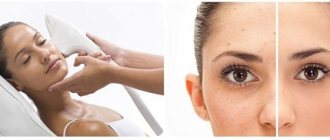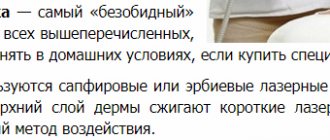CO2 laser skin resurfacing
CO2 laser skin resurfacing is a procedure that uses carbon dioxide (CO2) and a laser to remove scars, warts, stretch marks and deep wrinkles. Using this method, you can reduce the appearance of several signs of aging and get rid of some other imperfections.
The device uses intense light power to treat many aesthetic problems. Drooping bags under the eyes, acne scars and age spots are some of the most common problems that are addressed to cosmetology centers in Moscow and other cities. The procedure has a fairly high price, but if used correctly, this type of hardware intervention can significantly delay the need for surgical intervention.
Who is the procedure indicated for?
Among the patients interested in CO2 laser rejuvenation using the AcuPulse device, there are mainly women over 37 years old, who have begun to noticeably show signs of aging. The technology is especially popular among both women and men who have problems in the area around the eyes. This method helps to almost completely remove microwrinkles and the notorious “crow’s feet” on these delicate areas of the skin.
AcuPulse is also in demand among women after pregnancy who want to get rid of unsightly stretch marks, as well as among people with unaesthetic scars, consequences of burns, injuries and surgical interventions.
The procedure gives the most striking results in the presence of the following problems:
- a large number of wrinkles (both deep mimic and fine mesh wrinkles);
- acne, enlarged pores;
- impaired skin pigmentation (caused by age-related reasons, and appeared as a result of prolonged exposure to the sun), actinic keratosis;
- stretch marks, scars, scars, spider veins on any part of the body;
- too deep nasolabial folds that bother the patient;
- sagging skin, loss of tone, sagging tissue.
CO2 laser rejuvenation is an effective way to combat age-related skin changes. The technology can be used by persons aged 17 years or older. At the same time, doctors talk about the greatest effectiveness of laser rejuvenation for people who have passed the 40-year mark.
How does CO2 laser resurfacing work?
Ablative lasers, such as the CO2 laser, cause damage to the skin. The procedure removes a thin surface layer (epidermis) and heats the underlying layer (dermis). This stimulates the growth of new collagen fibers, the synthesis of which is slowed down for one reason or another. As the skin heals and new epidermal cells form, the treated skin becomes clearer, smoother, and firmer. Renewed skin is better supplied with blood and nutrients and absorbs care products better.
A similar effect can be achieved using non-ablative lasers such as pulsed light (IPL) devices. They do not damage the skin, but instead stimulate collagen synthesis and improve tone and texture. It is less invasive and requires less recovery time, while at the same time being less effective.
The cosmetologist chooses the type of laser depending on the patient’s existing problems and cosmetic goals.
Karachausheva Aksana Georgievna
- Dermatologist, cosmetologist.
- Doctor of the highest qualification category for planning individual anti-age programs for facial and body rejuvenation.
- Specializes in a combination of modern hardware and injection techniques for skin rejuvenation and treatment. Proficient in the technique of facial contouring and harmonization of appearance while preserving natural beauty and individuality, all methods of nourishing and cleansing the skin. Treats rosacea, rosacea, acne and skin hyperpigmentation.
- He is fluent in the new concept of rejuvenation and non-surgical SMAS facial lifting using high-intensity focused ultrasound on the Ultraformer device.
What are the benefits of carbon dioxide laser resurfacing?
CO2 laser skin resurfacing
Skin resurfacing using a CO2 laser can be used for the following cosmetic defects:
- Fine and deep wrinkles
- Age spots
- Uneven shade or texture
- Sun damaged skin
- Mild to moderate acne scars
- Large pores
- Superficial or deep hyperpigmentation.
Other applications of carbon dioxide grinding include:
- Seborrheic keratosis
- Non-malignant neoplasms of HPV
- Hyperplasia of the sebaceous glands
- Angiofibroma (fibrous nasal papule)
- Connective and complex nevi
- Lentigo spots
- Syringomas (intradermal papules)
- Epidermal melasma (increased skin pigmentation)
- Rhinophyma (tissue hypertrophy on the nose)
Indications for laser peeling
The essence of the hardware technique, called laser peeling (resurfacing, dermabrasion), is that under the influence of a laser beam, controlled damage to the epidermis occurs in order to start the process of skin renewal. During the procedure, due to the strong heating of the skin surface, some of its layers evaporate.
Laser peeling is a professional cosmetic procedure that gives a noticeable effect in the fight against imperfections and skin problems that are much worse dealt with by other methods. The face literally transforms after laser peeling. Moreover, the depth of exposure can be adjusted, focusing on the severity of skin flaws and their localization.
Using this procedure you can get rid of:
- scars and stagnant spots formed due to acne;
- scars and stretch marks (all over the body);
- sagging facial skin and wrinkles on it;
- sagging and thinning of the skin of the eyelids.
Laser peeling will be useful in the following cases:
- uneven skin texture;
- there are pigment spots on the face;
- too enlarged pores on the skin;
- dull complexion, lack of skin tone;
- there are milia;
- hyperkeratosis is observed.
When is CO2 laser resurfacing not recommended?
Like any procedure, laser rejuvenation has contraindications. The patient must carefully read this list, since laser exposure to the skin is a serious intervention with a risk of complications. Skin resurfacing is not recommended in the following cases:
- Active bacterial, viral or fungal infections
- Poor general health, inflammatory processes in the body
- Taking oral isotretinoin (Accutane) within the past 6 months
- Fitzpatrick skin phototypes 5-6 (very dark skin)
- Other resurfacing procedures within the previous 2-3 months
- Unwillingness to accept the possibility of complications
- Excessively thick or thin skin (determined by a doctor during consultation)
- Collagen vascular diseases
- Human immunodeficiency virus (HIV) or systemic infections
- Tendency to form keloid scars
- Metal piercing in the treated area
Compatible with other procedures
CO2 laser skin rejuvenation using the AcuPulse device is considered quite universal and easily compatible with other cosmetic procedures. It can be performed in parallel with biorevitalization, mesotherapy, bioreparation and plasma lifting. During the first week after the procedure, it is better to hold off on any methods of influencing the treated tissues, waiting for their complete regeneration. At this time, such activities as visiting the sauna, spa salons, solariums, and exposure to the open sun are especially prohibited.
If you have an appointment for other anti-aging courses, you should additionally check with your doctor how effective they will be in combination with a fractional laser.
CO2 laser rejuvenation is especially recommended for patients who are planning upper and lower eyelid surgery (blepharoplasty). The purpose of surgical manipulation is to eliminate fatty hernias that form with age. The impact of the AcuPulse CO2 laser promotes better skin contraction after surgery, evens out wrinkles around the eyes, reduces the rehabilitation period after surgery and allows you to maintain the resulting rejuvenation effect longer.
Is resurfacing with a CO2 laser painful and what to expect after?
This procedure is usually performed under anesthesia, so discomfort is minimal. This is a numbing cream that is applied directly to the skin. Other types of anesthesia are performed in selected situations and skin conditions that require deeper laser penetration.
After exposure to CO2 you can expect to feel a slight sunburn. You will also notice redness and swelling on the skin. Itching and mild tingling for several days are common. Depending on the intensity of treatment, the “sunburn” effect may be weaker or more severe. In these more severe cases of redness, scabs may appear as the skin heals.
Types of fractional photothermolysis
Fractional photothermolysis comes in two types:
- Ablative. The laser affects only the upper layers of the skin, at a depth of up to 1.5 mm. After the procedure, tiny wounds similar to red dots are visible on it. As a result of microdamage, the process of collagen and elastin production is launched, and the process of powerful cell regeneration is activated. The skin is noticeably tightened. Recovery takes a little longer than using a non-ablative method, but the effectiveness is slightly higher.
- Non-ablative. The laser affects the middle layer of the dermis (3-5 mm). Damage to the epidermis is so minor that it is invisible to the naked eye. Microthermal treatment zones are formed under the skin. As a result, the middle layer of the dermis is restructured and renewed. The first results can be seen two weeks after the procedure - wrinkles will gradually begin to smooth out. A pronounced effect will occur in a few months.
Non-ablative fractional photothermolysis is effective in preventing premature aging. The procedure is recommended for use at the age of 25-40 years.
Post-procedure care
Do not touch or rub your skin when brushing or showering, and avoid contact with hot water. The treated area must be cleaned 2 to 5 times a day, and also include protective products in your care that the cosmetologist will recommend.
The treatment area is peeled off during the recovery period to allow new cells to come to the surface. The new skin will be pink, like after a major scratch. Over time, the pinkness will go away, and during this period it is important to protect yourself from external influences, especially ultraviolet rays. Redness tends to last longer in people with fair skin, such as blondes and redheads. Full recovery may take up to a year.
How does the procedure work?
As mentioned above, the fractional photothermolysis procedure is very comfortable:
- The patient sits on a comfortable soft couch.
- The cosmetologist cleanses the skin in the treatment area from contaminants (dust, sweat), if necessary, performs makeup removal and treats the area with an antiseptic.
- The device is configured in accordance with the objectives of the procedure.
- The specialist treats the problem area using a special nozzle. The maximum that the patient experiences is a feeling of intense warmth and tingling. The depth and power of the impact can be adjusted during the process if necessary.
- At the end of the procedure, the cosmetologist disinfects the treated area and applies a light soothing cream to it.
How long does it take for the treated area to heal?
Facial restoration after CO2 laser resurfacing takes from 7 to 14 days, depending on the depth of beam penetration. After the procedure, swelling occurs. It peaks on the second or third day and then subsides by the fifth or seventh day. Redness and itching are normal and should not be a cause for concern. During the first week, varying degrees of crust formation are observed. It is necessary to apply open or closed dressings until complete healing.
Apply a light, water-based moisturizer for the next 2-3 weeks. Avoid products containing acids such as salicylic, glycolic, etc. in your daily care until the skin is completely restored. After healing, use sunscreen.
A return visit to the clinic where the procedure was performed is usually required after 2-3 days, then a week, 3-4 weeks, 3 months, 6 months and 1 year after resurfacing.
Fraxel re:store Dual fractional laser rejuvenation
Laser therapy and treatment using Fraxel technology are completely safe. The nature of the action of the technique and the comfort of its use allow us to consider Fraxel a “weekend procedure.”
Photothermolysis allows you to influence the skin at the epidermal level. The laser beam forms microthermal treatment zones on the skin in which coagulation occurs. Heat shock promotes intensive cell renewal.
Ablation destroys cells, creating micro-wells in the dermis in which new cells are produced. Depending on the purpose, there are three types of ablation:
- superficial - for the treatment of pigmentary malformations
medium – to eliminate vascular pathology
Fraxel fractional laser rejuvenation procedure
The results of a photothermolysis course last for years. Scars and stretch marks are removed permanently. Unlike contouring and botulinum toxin injections, with laser correction there are no dramatic changes in appearance: the skin simply returns to the state it was 5 – 10 years ago.
Protocol for the Fraxel photothermolysis procedure:
- Skin is cleared of cosmetics
- 40 – 60 minutes before the start of treatment, topical anesthesia is applied
- Before the procedure begins, the application anesthesia is removed and the skin is covered with a lubricant to ensure the laser tip glides
- The laser handle is passed over the skin in various directions within the treatment area. Unlike the stamp technique, laser impact is uniform and safe
- At the end of the procedure, the lubricant is removed and a special soothing cream is applied to the skin.
During the rehabilitation period, intensive restoration processes occur in the skin. Regular moisturizing must be used for at least two weeks after the procedure. Also, to avoid unwanted pigmentation, it is necessary to protect the skin from exposure to ultraviolet rays.
Frequently asked questions from patients wishing to undergo laser rejuvenation with the Fraxel device:
1. Are there any contraindications for Fraxel laser treatment?
Yes, these are classic contraindications for any laser procedures: epilepsy, pregnancy, inflammatory and oncological processes in the area of intended treatment, chemical peeling and similar procedures performed less than 2 weeks before treatment, psoriasis, atopic dermatitis in the acute stage. You should tell your doctor if you have an allergic reaction to lidocaine.
2. How should I prepare for the Fraxel procedure? How long before the procedure can I drink alcohol, go to the sauna, or engage in intense sports?
No special preparation is needed for the Fraxel procedure (Fraxel re:store and Fraxel re:store DUAL). You can exercise and go to the sauna in the morning before the procedure. Alcohol can be consumed in moderation even before the procedure.
3. Are any tests necessary before the Fraxel procedure?
You do not need to take any tests before the Fraxel procedure.
4. How long does one procedure take?
The procedure time depends on the area of the treated areas. For example, facial treatment takes 20-30 minutes, eyelid treatment – 5-10 minutes. Anesthetic cream is applied to the skin 40-60 minutes before the procedure.
5. How many procedures need to be done? Is there any result from one procedure?
The number of procedures depends mainly on the problem the patient is presenting with, the degree of its severity, as well as the aggressiveness of the procedure. Typically, this course of Fraxel re:store laser procedures consists of 3-5 sessions, carried out at intervals of 2 weeks to 2 months. There is a result from one procedure, but in order to achieve maximum effect, it is better to take a course of several procedures. When using the Fraxel re:store DUAL laser, the number of necessary procedures to remove age spots can be reduced to 1-2.
6. What areas can be treated with the Fraxel laser?
The Fraxel procedure can be performed on any area of the face and body, including delicate areas: eyelids (up to the eyelash edge), neck and décolleté.
7. How do you feel during the procedure?
During the procedure, you will feel warmth and moderate discomfort in the area where the doctor will touch the handle of the device. Since to ensure high efficiency, the Fraxel laser needs to penetrate the reticular layer of the dermis, where there are many pain receptors, it is unfortunately impossible to completely get rid of the feeling of warmth and moderate burning. The Fraxel procedure is performed using a superficial numbing cream that reduces discomfort. Also, during the procedure, cool air is blown onto the skin to increase comfort.
8. What will my face look like immediately after the procedure and the day after?
Immediately after the procedure, the face will be moderately red and minor swelling will be visible. It's like you've been over tanning in the sun. The next day the swelling will subside; redness may persist for 2 to 3 days. The skin's reaction to the procedure depends on individual characteristics, as well as on the intensity of treatment. If you want to hide the fact of the procedure from others, you can use foundation cosmetics.
9. What should you do after the procedure?
No special medical skin care is needed after the Fraxel procedure. In order for the redness to go away faster, the doctor may prescribe you cosmetics and topical medications that speed up the recovery process. You can use the Regenerative restoring cream from the SYSTEM nanogreen PROFI line, which is specially designed for use together with Fraxel. Within a month from the date of the procedure, it is necessary to protect the skin from ultraviolet rays - when going outside, use sunscreen SPF30 or higher.
10. What should not be done after the procedure?
Do not immediately after the procedure apply substances that have an irritating effect (for example, alcohol-containing lotions) to the treated area. For at least two weeks after the Fraxel procedure performed with the Fraxel re:store and Fraxel re:store DUAL lasers, you should refrain from any procedures that injure the skin (for example, peelings and dermabrasion)
11. Is there a danger of getting infected with something during the procedure?
There is no danger of infection during the Fraxel procedure if the doctor acts correctly. All Fraxel lasers are equipped with special replaceable tips (nozzles), which are thoroughly disinfected by medical staff after the procedure.
12. What complications occur after Fraxel procedures?
According to a study by Emmy M. Grabber et al., the following complications are possible after the Fraxel procedure: acne (acne) - 1.87 percent, facial herpes - 1.77 percent, post-inflammatory hyperpigmentation - 0.73 percent, prolonged (more than 4 - days) erythema - 0.83 percent and prolonged (more than 2 days) swelling - 0.62 percent. All these complications are possible with a correctly performed procedure, and all of them are successfully resolved within a month. It should be emphasized that the exact same complications occur with classical laser resurfacing (CO2 and erbium) tens of times more often. People often ask about other complications, but we can confidently say that with the Fraxel procedure performed correctly and following the doctor’s recommendations, there is no risk of scars, cancer, or keloid growth at the site of a regular scar.
(Research “Side effects and complications of fractional laser photothermolysis: Experience with 961 treatments” 2008)
13. At what age can Fraxel procedures be performed?
The Fraxel procedure can be performed at any age. It all depends on what you want to treat. Typically, anti-aging procedures are not performed before the age of 25. Pigmentation, post-acne, and stretch marks are treated already at the age of 14-16, and it makes no sense to treat stretch marks during the period of active growth and hormonal changes. Fraxel's youngest patients are typically children aged 5-7 years who are being treated for traumatic or surgical scars.
14. Can the Fraxel procedure be performed in spring and summer?
The Fraxel procedure can be performed at any time of the year, including spring and summer. But it must be remembered that melanogenesis in general and the appearance of pigmentation in particular are processes that are associated with the effect of ultraviolet radiation on the skin. It doesn't matter what time of year you do Fraxel - you should protect your skin from sun rays for at least a month after the procedure. This doesn’t mean you have to stay at home, you just don’t need to sunbathe, and when going outside, be sure to use sunscreen.
For reference: in California, the Fraxel procedure is performed all year round, and most of the year in this region of the United States is much sunnier than June and July in Moscow.
15. Why is anesthesia needed before the Fraxel procedure?
Fraxel penetrates deeply - up to 1.4 mm. On the scale of the skin, this is the deep reticular dermis. When forming microzones of influence, Fraxel can affect pain receptors that are located in the reticular layer of the dermis (there are more than 2000 of them per square centimeter). Unfortunately, it is impossible to destroy the skin at such a depth (and this is important if it is necessary to smooth out wrinkles) without pain. That’s why superficial anesthesia is used: it allows you to endure such a deep effect relatively comfortably.
16. Is it possible to use Fraxel to get rid of enlarged pores, even out complexion and remove acne?
Fraxel re:store (classic Fraxel) is used to reduce pores and treat post-acne. In the USA, the gold standard for post-acne treatment is the Fraxel re:store procedure.
To smooth out acne and reduce pores, 5 Fraxel re:store procedures are usually sufficient. The number of procedures depends on the age of the post-acne scars, your age, and the size of the scars. Detailed information can be obtained at a free consultation.
The Fraxel procedure does not specifically address acne or skin texture. This is fractional skin remodeling, the result of which is the smoothing of the surface (relief) and color of the skin, as well as its rejuvenation.
17. Can Fraxel help get rid of dark circles under the eyes?
Dark circles under the eyes are a phenomenon usually associated with stagnation of blood in the vessels. The skin on the eyelids and under the eyes is very thin, and oxygen-poor blood can show through, giving the skin a bluish tint. In addition, the area under the eyes may have more pigment at the epidermal level, which gives it a brown tint.
Fraxel tightens the skin and makes it healthier by stimulating blood circulation and also removes excess pigment. Therefore, Fraxel treatment under the eyes is quite effective in removing dark circles.
We recommend that you consult with your doctor, as dark circles can be either a normal physiological feature or a sign of a chronic disease.
18. Can Fraxel treatments be used to remove stretch marks on the breasts, particularly after breast augmentation?
It is absolutely safe to use this laser on any area of the body, including the breast area (including after mammoplasty). It's best to treat stretch marks as soon as they form, but it's important to prevent new ones from appearing. If you are planning further surgeries that increase volume, it is important for you to understand that new stretch marks may appear.
19. How harmful is laser radiation to the body during the Fraxel procedure?
Laser radiation from an erbium fiber optic laser (Fraxel re:store) is absolutely safe for the body. All Fraxel lasers belong to the class of infrared lasers. Infrared radiation itself is very common in the world around us. For example, about 48% of sunlight is infrared light. The dose of infrared light irradiation from the Fraxel procedure is hundreds of times less than from the emitters around you every day (for example, a radiator), moreover, infrared radiation can cause only one effect in the skin - heating. In the case of the Fraxel laser, this heating is strictly controlled, and it is the essence of the procedure.
20. What is the fundamental difference in the effects of phototherapy and Fraxel?
The fundamental difference between Fraxel and photorejuvenation is that Fraxel forms micro-zones of influence in the skin by heating water, while photorejuvenation (IPL) heats pigments in the skin (melanin primarily). Therefore, in the case of photorejuvenation, treatment is effective mainly for surface pigment and on light skin, and in the case of Fraxel, pigment of any depth is removed and on skin of any color type.
21. How harmful are the effects on vision from Fraxel eyelid procedures?
Absolutely harmless if the procedure is carried out correctly. Fraxel is the only fractional laser that is FDA approved for eyelid procedures. Special narrow tips are used that allow the doctor to work right up to the eyelash edge. At the same time, due to the fact that the skin in the upper eyelid area is very thin, special parameters of the Fraxel re:store procedure are used.
22. How long after the filler injection can I undergo the Fraxel procedure if the instructions for the filler indicate not to use it in conjunction with laser therapy?
Fraxel procedures can begin 2-4 weeks after the injection of fillers. But we must take into account the fact that any laser procedure is thermal and can accelerate the biodegradation of fillers. Alternatively, during the procedure you can avoid touching the skin areas above the installed fillers.
23. Can Fraxel help get rid of fine lines and crow's feet around the eyes?
For facial wrinkles, injections of botulinum toxin preparations (for example, Botox or Dysport) are used. They work well with Fraxel treatments. Botox does not affect the surface of the skin, it simply relaxes the facial muscles, so it is better to do it together with Fraxel Botox to smooth out the skin texture where grooves have already formed.
24. Can the Fraxel procedure be performed if spider veins are visible on the face and nose?
Vascular tissue and other vascular disorders (for example, rosacea) are not a contraindication to the use of Fraxel. Please note that the Fraxel procedure is aimed at rejuvenation, evening out the relief and color of the skin, but it does not affect deep enough vessels. If you want to get rid of spider veins, we recommend undergoing the IPL procedure (for example, using the Quantum device).
25. Why should you not be in the sun for 3 months after the Fraxel procedure and what could be the consequences after exposure to sunlight?
Fraxel, like a number of other cosmetic procedures, enhances metabolic processes in the skin. If, after the Fraxel procedure, the skin is exposed to ultraviolet rays (sunlight or solarium), there is a risk of causing the appearance of age spots (hyperpigmentation).
Therefore, the Fraxel procedure can be done if you do not plan to sunbathe for 1-3 months after the procedure. This period will be determined more precisely by your attending physician, since the risk of developing hyperpigmentation also depends on your individual characteristics. If you plan to travel to sunny countries after the Fraxel procedure, do not forget about sunscreen (SPF30 or higher).
26. How long does the effect last after 4-5 Fraxel treatments? How soon can it be repeated?
It is impossible to accurately calculate how long the effect of Fraxel treatment will last, but it will last longer than a month or a year. Fraxel restores youth to your skin, but it does not “freeze” it and does not affect the rate of its aging. After 4-5 treatments, the quality of your skin will change - it will look younger, but after that the skin will continue to age the same way as before. Those. the effect will not last for 10 years. The rate of skin aging will depend on many factors: your lifestyle, genetics, hormonal status, bad habits, etc. If you lead a healthy lifestyle and take care of your skin, the effect will last longer. If it’s the other way around, the skin will age earlier than before Fraxel.
We recommend that all patients, after a course of 4-5 procedures, undergo one maintenance procedure once a year.
Sign up for a free consultation with a cosmetologist
You can call us
by phone: +7 (495) 6780558
We are always glad to see you!
What are the possible side effects of CO2 laser resurfacing?
The following transient side effects may occur after exposure to a fractional laser:
- Swelling
- Erythema (redness)
- Itching
- The appearance of acne
- Hyperpigmentation
- Infection (bacterial, viral, fungal)
- Contact dermatitis
- Hypopigmentation (loss of skin pigment)
- Demarcation lines
- Hypertrophic scars and keloids
- Damage to tooth enamel
- Eye injuries
- Post-inflammatory hyperpigmentation
Sign up for the procedure
Price: 5000 rub (upper or lower eyelids)
Do you want to get rid of dull complexion and various skin imperfections in just one procedure? Thanks to CO2 Light fractional laser peeling, your skin will regain its natural radiance and smoothness! The beam of the AcuPulse device not only removes damaged cells on the surface of the skin, erasing all imperfections, but also forms healing microzones in the epidermis, renewing it from the inside. Developed by the renowned company Lumenis, the AcuPulse laser is one of the most advanced CO2 lasers in the world. Its unique ultra-short pulse allows you to achieve impressive results with no side effects.
The laser peeling procedure has become a real must-have for girls over 25 who care about the beauty, health and youth of their skin.
Why is it worth undergoing a laser peeling procedure with us? The Premium Aesthetics Academy of Cosmetology is the only clinic in Moscow opened by the official distributor of the AcuPulse laser in Russia. We can guarantee impeccable quality of the procedure and affordable cost.










